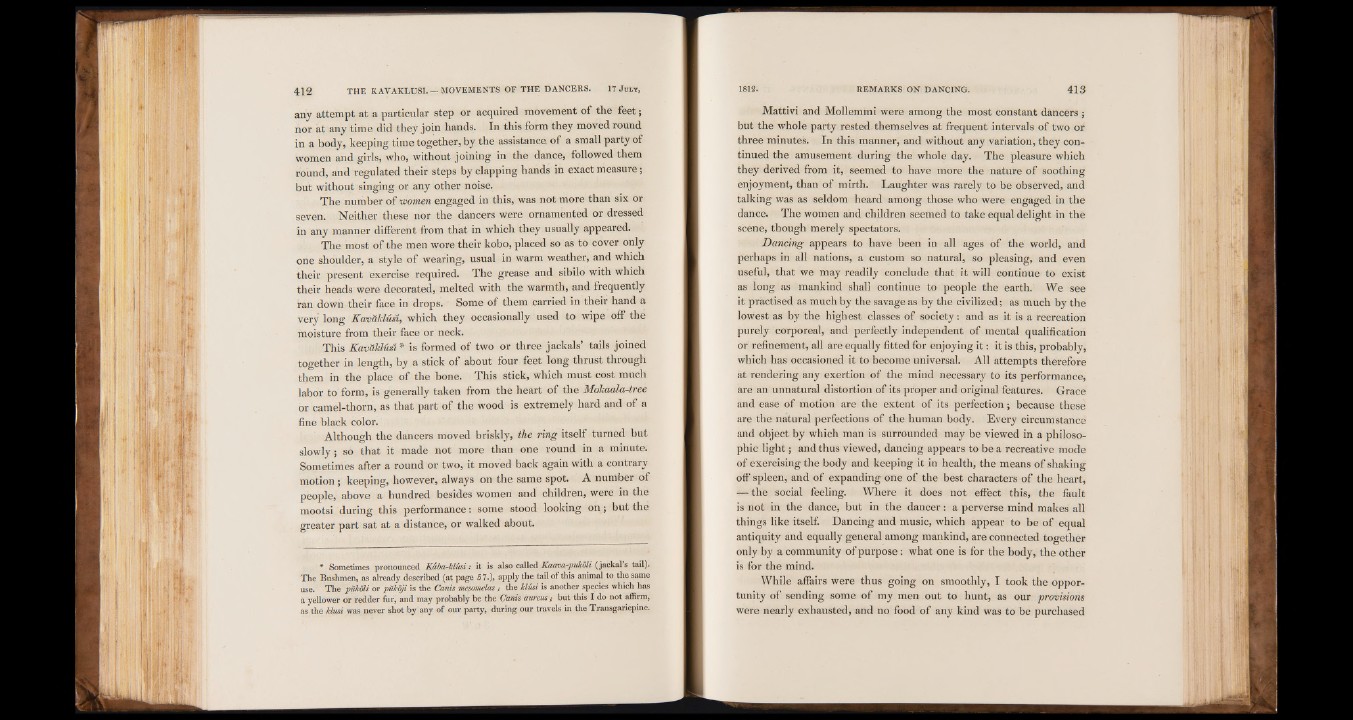
any attempt at a particular step or acquired movement of the feet;
nor at any time did they join hands. In this form they moved round
in a body, keeping time together, by the assistance of a small party of
women and girls, who, without joining in the dance, followed them
round, and regulated their steps by clapping hands in exact measure;
but without singing or any other noise.
The number of women engaged in this, was not more than six or
seven. Neither these nor the dancers were ornamented or dressed
in any manner different from that in which they usually appeared.
The most of the men wore their kobo, placed so as to cover only
one shoulder, a style of wearing, usual in warm weather, and which
their present exercise required. The grease and sibilo with which
their heads were decorated, melted with the warmth, and frequently
ran down their face in drops. Some of them carried in their hand a
very long Kav&klvM) which they occasionally used to wipe off the
moisture from their face or neck.
This Kavdklust £ is formed of two or three jackals’ tails joined
together in length, by a stick of about four feet long thrust through
them in the place of the bone. This stick, which must cost much
labor to form, is generally taken from the heart of the Mokaalu-tree
or camel-thorn, as that part of the wood is extremely hard and of a
fine black color.
Although the dancers moved briskly, the ring itself turned but
slowly; so that it made not more than one round in a minute.
Sometimes after a round or two, it moved back again with a contrary
motion ; keeping, however, always on the same spot. A number of
people, above a hundred besides women and children, were in the
mootsi during this performance: some stood looking on ; but the
greater part sat at a distance, or walked about.
* Sometimes pronounced Kába-klúsi: it is also called Kaava-pulcdli (jackal s tail).
The Bushmen, as already described (at page 57.), apply the tail of this animal to the same
use. The pttkdli or pükqji is the Canis mésamelas ; the must is another species which has
a yellower or redder for, and may probably be the Canis aureus ; but this I do not affirm,
as the Musi was never shot by any of our party, during our travels in the Transgariepine.
Mattivi and Mollemmi were among the most constant dancers;
but the whole party rested themselves at frequent intervals of two or
three minutes. In this manner, and without any variation, they continued
the amusement during the whole day. The pleasure which
they derived from it, seemed to have more the nature of soothing
enjoyment, than of mirth. Laughter was rarely to be observed, and
talking was as seldom heard among those who were engaged in the
dance. The women and children seemed to take equal delight in the
scene, though merely spectators.
Dancing appears to have been in all ages of the world, and
perhaps in all nations, a custom so natural, so pleasing, and even
useful, that we may readily conclude that it will continue to exist
as long as mankind shall continue to people the earth. We see
it practised as much by the savage as by the civilized; as much by the
lowest as by the highest classes of society: and as it is a recreation
purely corporeal, and perfectly independent of mental qualification
or refinement, all are equally fitted for enjoying it : it is this, probably,
which has occasioned it to become universal. All attempts therefore
at rendering any exertion of the mind necessary to its performance,
are an unnatural distortion of its proper and original features. Grace
and ease of motion are the extent of its perfection; because these
are the natural perfections of the human body. Every circumstance
and object by which man is surrounded may be viewed in a philosophic
light; and thus viewed, dancing appears to be a recreative mode
of exercising the body and keeping it in health, the means of shaking
off spleen, and of expanding one of the best characters of the heart,
— the social feeling. Where it does not effect this, the fault
is not in the dance, but in the dancer: a perverse mind makes all
things like itself. Dancing and music, which appear to be of equal
antiquity and equally general among mankind, are connected together
only by a community of purpose: what one is for the body, the other
is for the mind.
While affairs were thus going on smoothly, I took the opportunity
of sending some of my men out to hunt, as our provisions
were nearly exhausted, and no food of any kind was to be purchased